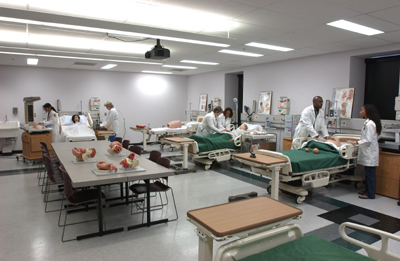Online Course
Nurs 791 - Instructional Strategies and Assessment
Module 5: Collaborative Teaching Strategies
Laboratory
The laboratory is an instructor-supervised environment facilitating the applied execution of investigation exercises, observation, and experimentation by a class. Specifically, lab exercises allow students to apply information learned from lectures to problems and projects. This environment can include utilizing audio-visual aids, interactive-computer programs and specialized equipment set-ups. Working collaboratively or in small groups, students use labs to focus on the application of a particular subject.
BENEFITS OF LABORATORY LEARNING
- – Practice in safe environment
Labs allow students in the healthcare field to learn and practice in a safe, controlled environment that simulates hospital reality situations utilizing modern equipment. This teaching strategy assists in enhancing a student' clinical and critical thinking skills and allows a student to practice a clinical skill for the first time in a safe environment, prior to performing the skill in a patient care environment for the first time.

- – Responsibility for learning
Students in the laboratory setting are expected to be self-directed and take responsibility for their learning. The Laboratory instructors are always present to answer questions and guide the students to facilitate their learning (Taylor & Cleveland, 1984).
- – Feedback and reflection
The laboratory environment enables students to practice skills and problem solve while receiving valuable feedback from instructors or peers. Students are able to reflect on the feedback received to further develop their skills or solve problems in the lab.
REQUIREMENTS OF A LABORATORY
- Prior learning in the classroom
A goal of the laboratory environment is for students to apply the theory gained in a lecture to the practical aspects of the technical performance of a skill. Hence taking the information from the cognitive domain and using it in the psychomotor domain. An example of this would be medication administration. In the theory portion of the class the students would learn the principles of medication administration. Following a classroom lecture on the principles of medication administration, the students would use the principles learned and apply them in the laboratory in order to prepare and administer the medication safely.
2- Specific objectives
Specific objectives in the laboratory classroom tell the students what they are expected to do and guide their learning. Instructors utilize objectives to measure and evaluate the students’ success.
3- Effective teachers
Effective teachers in the laboratory setting must be able to quickly identify individual students’ strengths and weaknesses and challenge or help students to develop higher-level thinking skills and problem solving skills. In order for students to thrive in this setting, the instructor must create a climate so that students feel safe enough to ask and answer questions and to participate in discussions within the laboratory setting.
4- Appropriate equipment
In order for students to be able to execute “hands-on” learning in the laboratory, the appropriate equipment must be available. Without the appropriate equipment students will not obtain the intended objectives.
The simulation labs at the University of Maryland School of Nursing will be discussed in Module 6.
This website is maintained by the University of Maryland School of Nursing (UMSON) Office of Learning Technologies. The UMSON logo and all other contents of this website are the sole property of UMSON and may not be used for any purpose without prior written consent. Links to other websites do not constitute or imply an endorsement of those sites, their content, or their products and services. Please send comments, corrections, and link improvements to nrsonline@umaryland.edu.